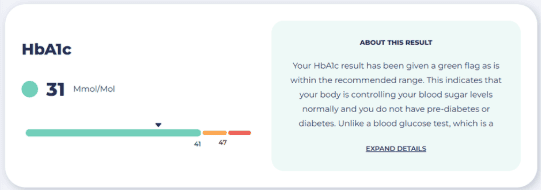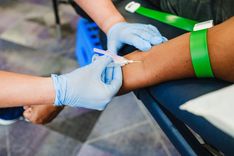
What is the HbA1c test?
The HbA1c test, also known as the glycated haemoglobin test, is a simple but powerful blood test that provides insight into your average blood sugar levels over the previous 2 or 3 months. It plays a key role in highlighting risk and monitoring type 2 diabetes and pre-diabetes, helping individuals to make informed decisions about their health, lifestyle and treatment.
How does a HbA1c test work?
When sugar (glucose) circulates in your bloodstream, it can attach to haemoglobin – the protein in red blood cells that carries oxygen. This combination forms glycated haemoglobin (HbA1c). Since red blood cells live for about 2-3 months, measuring the percentage of HbA1c gives a reliable picture of your long-term blood sugar control.
Unlike standard glucose tests, which only show your blood sugar level at a single point in time, the HbA1c test reflects your average levels over a longer period. This makes it particularly useful in identifying trends and risks that could otherwise go unnoticed.
Why is the HbA1c test important?
High HbA1c levels can be an indicator of poor blood sugar control, which can increase the risk of serious health complications such as:
-
Heart disease and stroke
-
Kidney damage
-
Eye problems
-
Nerve damage
Even if you haven’t been diagnosed with diabetes, regularly checking your HbA1c levels can help you understand your risk and monitor any changes, which would allow you to take proactive steps to improve your health if your levels get flagged. These changes could include a healthier diet, losing weight or simply increasing your activity levels.
Who should have the HbA1c test?
People living with diabetes should have a HbA1c blood test at least annually, but some may need more regular checks if their blood sugar level readings are too high. This blood test is also recommended for those who:
-
Have symptoms of diabetes or pre-diabetes
-
Have a family history of diabetes
-
Are overweight or have other risk factors
At Bluecrest, the HbA1c test is available as standard in all our business packages – giving you access to this insightful data, no matter your package.
What do the results mean?
When you receive your results, you will clearly be able to see where you fall on the sliding scale of green, amber or red, as shown below.

If you were to receive an amber result it could suggest that your body is not controlling your blood sugar levels normally and could indicate pre-diabetes. It would be recommended that you seek further investigation and speak to a healthcare professional. A red result would indicate your body isn’t controlling your blood sugar levels normally and that you may have diabetes - this would require further investigation from your healthcare professional.
If you have diabetes, you will have a slightly different range and flags, if your HbA1c test comes back as amber or red it would suggest that your diabetes is not optimally controlled and the recommendation would be to seek additional advice from your healthcare professional to discuss this further.
Want to find out insights about your health? Book your health assessment today!
To book your health assessment, click here
For Vitality customers, book here.
For Benenden customers, book here.
Need help? You can reach out to our corporate team on 0808 168 9219

Tiegan Hill
Corporate Marketing Assistant
Anna Jones
Chief Nursing Officer, Bluecrest



